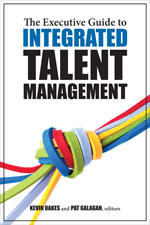 True confessions time: even though I’m in the field of talent management, I’ve never been 100% clear on exactly what that term encompasses. Ironic, isn’t it? Some folks in the industry focus on recruiting and hiring practices, others on employee skill development. Now, there’s a book on the market that corrals all the various facets housed under the vague term and creates a unified meaning.
True confessions time: even though I’m in the field of talent management, I’ve never been 100% clear on exactly what that term encompasses. Ironic, isn’t it? Some folks in the industry focus on recruiting and hiring practices, others on employee skill development. Now, there’s a book on the market that corrals all the various facets housed under the vague term and creates a unified meaning.
It’s called The Executive Guide to Integrated Talent Management. A collaborative effort between The Institute for Corporate Productivity and the American Society for Training and Development, the book brings together the best ideas of academics, consultants and practitioners into one place. Each chapter is authored by one or more thought-leaders and overall, the book succeeds in providing a semblance of order to a complex set of human resources disciplines.
Still wondering just exactly this book is about? Editors Kevin Oakes and Pat Galagan have organized the content into six key components:
- Recruiting
- Compensation and Rewards
- Performance Management
- Succession Management
- Engagement and Retention
- Leadership Development
Four Things I Liked About This Book
- A thorough treatment of the topic. (Nope, no fables in this book.) Only solid, well-researched information with interesting visuals and case studies to support the concepts outlined.
- Stellar contributing authors. Popular and well-respected gurus such as Marshall Goldsmith and Dave Ulrich contribute alongside less-known, but very accomplished practitioners like Karen Paul and Cindy Johnson of 3M.
- Variety of writing styles and concepts. Each author writes in his/her own voice, contributing many different concepts from which you can draw your own conclusions.
- Gender parity of authors. OK, I’m on my soapbox now, but it’s refreshing to see a relatively equal number of male and female contributing authors tackle this subject.
A Misleading Title?
The only issue I have with the book is its title. Naming it the Executive’s Guide may overlook a very important readership market segment—talent management practitioners. Sure, this book is a great read for executives, but I believe it’s even more important for an HR generalist, training specialist or organizational development consultant to crack the cover and glean this important information. Talent management professionals who dig deeply into this book are in a much better position to communicate with executives about human capital issues.
And that, in my opinion, is what makes this book worth reading.
Disclosure: I received a copy of this book for the purposes of reviewing it. It passed muster with me so I’m sharing this information with you. Also, it would be a real drag for the Feds to show up and haul me away, so I’m following the rules set forth by the FTC. Some of the links in the above post are affiliate links, meaning if you click on the link and purchase the item (looking is free), I will receive a commission. Hey, a girl’s gotta find a way to cover her blogging habit, right?
Leave a Reply